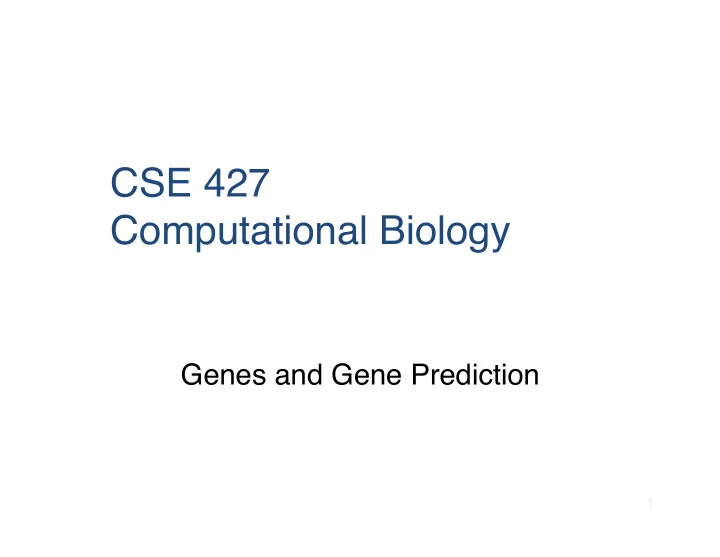

CSE 427 Computational Biology Genes and Gene Prediction 1
Gene Finding: Motivation Sequence data flooding in What does it mean? protein genes, RNA genes, mitochondria, chloroplast, regulation, replication, structure, repeats, transposons, unknown stuff, … More generally, how do you: learn from complex data in an unknown language, leverage what’s known to help discover what’s not 2
Protein Coding Nuclear DNA Focus of these slides Goal: Automated annotation of new seq data State of the Art: In Eukaryotes: predictions ~ 60% similar to real proteins ~80% if database similarity used Prokaryotes better, but still imperfect Lab verification still needed, still expensive Largely done for Human; unlikely for most others 3
Biological Basics Central Dogma: DNA transcription RNA translation Protein Codons: 3 bases code one amino acid Start codon Stop codons 3 ’ , 5 ’ Untranslated Regions (UTR ’ s) 4
RNA Transcription (This gene is heavily transcribed, but many are not.) 5
Translation: mRNA → Protein Watson, Gilman, Witkowski, & Zoller, 1992 6
DNA (thin lines), RNA Pol (Arrow), mRNA with attached Ribosomes (dark circles) Darnell, p120 7
Ribosomes Watson, Gilman, Witkowski, & Zoller, 1992 8
Codons & The Genetic Code Ala : Alanine Arg : Arginine Second Base U C A G Asn : Asparagine Phe Ser Tyr Cys U Asp : Aspartic acid Phe Ser Tyr Cys C Cys : Cysteine U Leu Ser Stop Stop A Gln : Glutamine Leu Ser Stop Trp G Glu : Glutamic acid Leu Pro His Arg U Gly : Glycine Leu Pro His Arg C His : Histidine C Leu Pro Gln Arg A Ile : Isoleucine Third Base First Base Leu Pro Gln Arg G Leu : Leucine Ile Thr Asn Ser U Lys : Lysine Ile Thr Asn Ser C Met : Methionine A Ile Thr Lys Arg A Phe : Phenylalanine Met/Start Thr Lys Arg G Pro : Proline Val Ala Asp Gly U Ser : Serine Val Ala Asp Gly C Thr : Threonine G Val Ala Glu Gly A Trp : Tryptophane Val Ala Glu Gly G Tyr : Tyrosine Val : Valine 9
Idea #1: Find Long ORF ’ s Reading frame: which of the 3 possible sequences of triples does the ribosome read? Open Reading Frame: No internal stop codons In random DNA average ORF ~ 64/3 = 21 triplets 300bp ORF once per 36kbp per strand But average protein ~ 1000bp 10
A Simple ORF finder start at left end scan triplet-by-non-overlapping triplet for AUG then continue scan for STOP repeat until right end repeat all starting at offset 1 repeat all starting at offset 2 then do it again on the other strand 11
Scanning for ORFs * 1 2 3 U U A A U G U G U C A U U G A U U A A G A A U U A C A C A G U A A C U A A U A C 4 5 6 * In bacteria, GUG is sometimes a start codon… 12
Idea #2: Codon Frequency In random DNA Leucine : Alanine : Tryptophan = 6 : 4 : 1 But in real protein, ratios ~ 6.9 : 6.5 : 1 So, coding DNA is not random Even more: synonym usage is biased (in a species dependant way) examples known with 90% AT 3 rd base Why? E.g. efficiency, histone, enhancer, splice interactions 13
Idea #3: Non-Independence Not only is codon usage biased, but residues (aa or nt) in one position are not independent of neighbors How to model this? Markov models 14
Recommend
More recommend